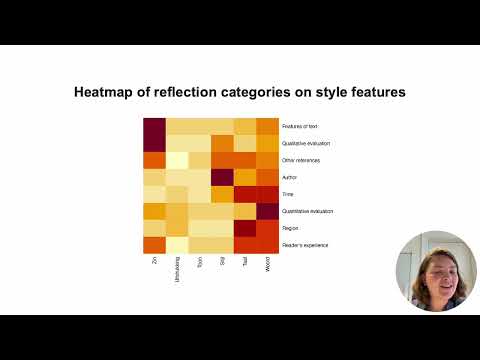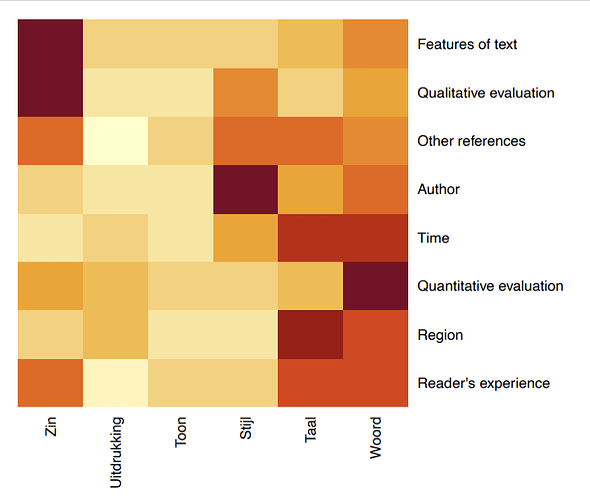 Speaker: Ekaterina Tereshko @Katja
Speaker: Ekaterina Tereshko @Katja
 Affiliation: Huygens Instituut, KNAW
Affiliation: Huygens Instituut, KNAW
Title: Reader’s experience of style aspects reflected in online book reviews: a tentative model of style perception
Abstract (long version below): We aim to investigate how readers perceive style. For this we study how often and in what terms book reviewers note features of style. The investigation consists of three steps. We annotated 200 online reviews to indicate mentions of style and aspects of style, and which words reviewers use that refer to style. Second, we use these words to query a corpus of N= 382,207 reviews to find the most used characteristics of style. Third, we focus on notions of style related to readers’ experience to develop a tentative model of reader perception of style.

 Long abstract
Long abstract
Online book reviews offer a large potential to investigate digital social reading (Rebora et al., 2021) and the impact of books as reflected in reader reviews (Milota 2014, Wang et al. 2019, Koolen et al. 2020). Most attention so far went to the style of reviews themselves (see Hu, Nan, et al. 2012, Ludwig S. et al. 2013), but not to reflections on the style of a reviewed book. However, understanding how readers write about style could provide information on how aspects of (Dutch) literature style are described and evaluated and help us to establish a basis for quantitative research on style perception.
We define style as an ensemble of text features that can be investigated quantitatively and qualitatively (following Herrmann, Van Dalen-Oskam and Schöch, 2015), but we add that style reflects a narrative point of view, as Leech and Short (2007, p. 151) mention. This means that we should see style not only as a “dress of thought”, but also as a “vector of thought”. If we accept that style can influence the perception of a text (see also Fialho 2007, Peer et al. 2021), we can say that style is able to direct the thoughts and attention of the readers, who perceive the literary text and conceptualise their own experiences, among others their perception of style, from the point of view based on their life experience.
To investigate to what extent and in what way the style of books is perceived and understood in online reviews, we use BlackLab[1] to analyse a corpus of Dutch reviews - ODBR (Boot 2017) - containing N= 382,207 online book reviews from different platforms, totalling over 45 million words.
Our first step is to reveal how often readers mention style in the reviews and in which manner they reflect on it. Then we classify the mentioned characteristics of style in book reviews. Lastly, we reveal the associative effects of style. We annotate 200 randomly selected reviews for content and find that style (alogside narrative, reflection, author etc.) appears in more than 40% of the reviews. After that we focus on nouns and search for adjective-noun (AN) combinations[2] as the nouns are often characterised by adjectives, and in these adjectives lies the emotional or cognitive reaction of the reader which we also broadly call impact (more about the notion of impact in Boot P., Koolen M. 2020). We then classify the AN combinations according to one of the corpus-driven categories. Note that we have to deal with two notions of style: the category that we aim to reconstruct, and style as one of the nouns from reviews.
Among the relevant words, more concrete (word, sentence and expression) and more abstract (style, tone and language) concepts can be distinguished. Figure 1 shows a heatmap of associations of style-related nouns with reaction-related adjective categories (for statistics see Tabel 1). Our expectation is that more abstract concepts evoke more associations reflecting readers’ experiences, but results contradict this expectation: most associations in the reader’s experience (of style) category associate with the words ‘taal’ (language) and ‘toon’ (tone), while such associations with ‘stijl’ (style) are almost the least frequent there. The word ‘stijl’ is most closely related to the author and qualitative evaluation (good or bad). Qualitative evaluation is strongly related to the notion of ‘zin’ (sentence), but ‘zin’ is also defined by the features of the text. Notable are differences between ‘zin’ (sentence) and ‘woord’ (word): while ‘zin’ relates to textual features, ‘woord’ associates with contextual features (time and region) and evokes reader’s reactions (see Figure 1).
Figure 1 . Heatmap of reflection categories on style features. Beneath from left to right: sentence, expression, tone, style, language, word.
| Stijl | Taal | Toon | Woord | Zin | Uitdrukking | |
|---|---|---|---|---|---|---|
| Reader’s experience | 29% | 57% | 77% | 39% | 28% | 34% |
| Qualitative evaluation | 26% | 4% | 6% | 10% | 24% | 7% |
| Features of text | 5% | 7% | 1% | 16% | 39% | 4% |
| Other references | 10% | 6% | 12% | 4% | 4% | 5% |
| Author | 19% | 4% | 3% | 4% | 1% | 1% |
| Region | 1% | 19% | 1% | 10% | 2% | 40% |
| Time | 2% | 3% | 1% | 2% | 0% | 3% |
| Quantitative evaluation | 0% | 1% | 0% | 12% | 2% | 5% |
Table 1 . The percentage shows how often the nouns related to style in online book reviews are defined by adjectives of each category. Columns from left to right: style, language, tone, word, sentence, expression.
Finally, we look at the category of reader experience. We assume this category is most directly related to the impact of style. To infer cognitive and emotional effects reflected in book reviews, we again classify AN-combinations. We apply principles of cognitive metaphors to the readers response to stylistic features, since we believe in the principle, which can generally be described as unfamiliar is understood in terms of familiar, or as Pragglejaz Group defines conceptual metaphor with more concrete and bodily oriented source domain (Pragglejaz, 2007, p. 5). Speaking about the reviews we do not consider them to be a creative work such as a literary text, but to reflect mainly conventional reactions on style among other features of books, and these reactions can take a metaphorical form. Not all examples in this category are metaphorical though, so we create a mixed classification with metaphorical (sharp sentences, warm words, raw style) and non-metaphorical (difficult language) characteristics. We were able to distinguish several associative categories for each style-noun and found that style as a book element (following the words style, language, word, sentence) is most often understood in terms of difficulty (difficult/easy/readable/understandable words/language). We also note whether the style is described as familiar or unfamiliar, and style is talked about in terms of physical objects, e.g. soft/big/expensive/clear/fuzzy/empty words or woolly/hard/raw/spicy/bombastic language. We found differences between perceptions of different features of style. For example, words are perceived to be emotional (funny/evil/unfunny/untouchable), whereas language evokes spatial associations (direct language). This gives us a tentative impression of the impact of style as such contributes to the empirical study of response to style. The follow-up to this work could be an investigation of the texts to which readers respond as to (not) difficult or (not) familiar, following the traditions of foregrounding studies.
Literature:
Boot, Peter. “A Database of Online Book Response and the Nature of the Literary Thriller.” DH. 2017.
Boot, Peter and Marijn Koolen (2020). “Captivating, splendid or instructive? Assessing the impact of reading in online book reviews”. In: Scientific Study of Literature 10.1, pp. 66–93. DOI: http://doi.org/10.1075/ssol.20003.boo.
Fialho, Olívia da Costa. “Foregrounding and refamiliarization: understanding readers’ response to literary texts.” Language and Literature 16.2 (2007): 105-123.
Herrmann, J. Berenike, Karina van Dalen-Oskam, and Christof Schöch. “Revisiting style, a key concept in literary studies.” Journal of literary theory 9.1 (2015): 25-52.
Hu, Nan, et al. “Manipulation of online reviews: An analysis of ratings, readability, and sentiments.” Decision support systems 52.3 (2012): 674-684.
Leech, Geoffrey N., and Mick Short. Style in fiction: A linguistic introduction to English fictional prose. No. 13. Pearson Education, 2007.
Ludwig, Stephan, et al. “More than words: The influence of affective content and linguistic style matches in online reviews on conversion rates.” Journal of marketing 77.1 (2013): 87-103.
Milota, Megan. “From “compelling and mystical” to “makes you want to commit suicide”: Quantifying the spectrum of online reader responses.” Scientific Study of Literature 4.2 (2014): 178-195.
Peer, Willie van, Paul Sopčák, Davide Castiglione, Olivia Fialho, Arthur M. Jacobs and Frank Hakemulder. “Foregrounding”. Handbook of Empirical Literary Studies , edited by Donald Kuiken and Arthur M. Jacobs, Berlin, Boston: De Gruyter, 2021, pp. 145-176. https://doi.org/10.1515/9783110645958-007
Pragglejaz Group. “MIP: A Method for Identifying Metaphorically Used Words in Discourse.” Metaphor and Symbol 22(1) (2007): 1–39. doi:10.1080/10926480709336752
Rebora, Simone, et al. “Digital humanities and digital social reading.” Digital Scholarship in the Humanities 36.Supplement_2 (2021): ii230-ii250.
Wang, Kai, Xiaojuan Liu, and Yutong Han. “Exploring Goodreads reviews for book impact assessment.” Journal of Informetrics 13.3 (2019): 874-886.
Footnotes
[1]: See: BlackLab (for data please mail the author)
[2]: The used AN combinations for each of the six nouns (stijl ‘style’, taal ‘language’, toon ‘tone’, woord ‘word’, zin ‘sentece’ and uitdrukking ‘expression’), each set categorised in eight groups (Reader experience, Qualitative and Quantitative evaluation, Features of text, References to the author, period and region ad Other references), can be accessed via Zenodo: Adjective+noun phrases that readers use in reviews to refer to the style of the text | Zenodo


